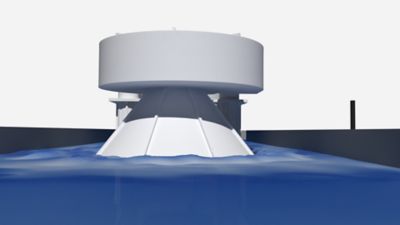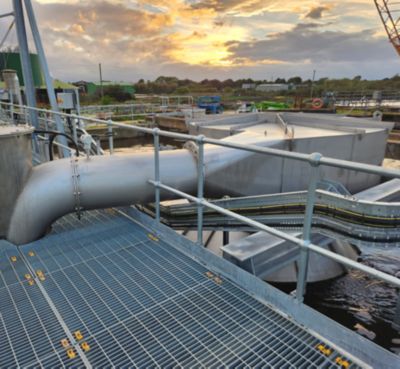Case Study
-
-
学生向け無料ソフトウェアにアクセス
Ansysは次世代の技術者を支援します
学生は、世界クラスのシミュレーションソフトウェアに無料でアクセスできます。
-
今すぐAnsysに接続!
未来をデザインする
Ansysに接続して、シミュレーションが次のブレークスルーにどのように貢献できるかを確認してください。
国および地域
無料トライアル
製品およびサービス
リソースとトレーニング
当社について
Back
製品およびサービス
“The Ansys Startup Program has given us access to the range of tools needed for comprehensive computational fluid dynamics and finite element analysis. By running simulations on the cloud, we can unlock the potential to learn new things quickly about the performance of our products for different applications. The resulting insights gained ahead of construction or installation of our wastewater management solutions are massively valuable to us as a startup and our customers across the industry."
— Sean Mulligan, Chief Executive Officer, VorTech Water Solutions
According to the United Nations Environment Programme (UNEP), wastewater is a growing health and environmental threat. Yet with the right infrastructure in place, it has the potential to become a significant source of reusable water and alternative energy.1 VorTech Water Solutions, an energy-efficient water and wastewater solutions specialist, has developed a groundbreaking platform of water treatment technologies based on vortex and cyclonic flows to solve water and wastewater challenges. The company envisions the global deployment of its products — including its advanced Vortex Power Aeration (VPA) technology — to enhance the sustainability and resilience of water and wastewater treatment infrastructure for future generations.
Challenges
Today approximately 80% of all industrial and municipal wastewater worldwide is released back into the environment without being treated or reused.2 Additionally, 20% of the world's population doesn't have enough water to sustain its needs.2 As populations and production continue to rise, the wastewater industry faces some immense challenges for the foreseeable future. One of the biggest challenges is connecting humanity to clean, potable water sources. All must be managed within the context of rapidly aging infrastructure and increasingly stringent treatment regulations designed to protect public health and the environment. Furthermore, global water use, treatment, storage, and distribution contribute to 10% of global greenhouse gas emissions,3 incentivizing the need for more sustainable industry solutions.

Figure 1. A visual comparison of the traditional aeration technologies and the new Vortex Powered Aeration (VPA) technology
Engineering Solutions
Thanks to the Ansys Startup Program and CADFEM UKI, an Ansys Elite Channel Partner, VorTech now has full access to multiphysics software coupled with high-performance computing (HPC) for comprehensive analysis of its water treatment technologies. CADFEM UKI coordinated access to Ansys licenses and on-demand HPC resources via CADFEM portal linked to AWS. This enabled VorTech to quickly adopt numerical methods for its processes and scale up simulations as required, specifically:
- VorTech used Ansys Fluent fluid simulation software for CFD analysis to understand the hydraulics taking place inside its VPA technology, then optimize and demonstrate mixing efficiency during wastewater treatment.
- Fluent-enabled CFD analysis was then coupled with FEA for fluid-structure interaction (FSI) analysis using Ansys Mechanical simulation software, which has become foundational to VorTech's structural design and technology development process.

Figure 2. Surface flow around a VPA unit, as simulated in Ansys 2022 R1

Figure 3. Surface flow simulated around multiple VPA units installed in oxidation ditches. Simulations conducted in Ansys 2022 R1.
Benefits
- Access to Ansys solvers at an affordable price point via the Ansys Startup Program enabled VorTech to design and develop an advanced aeration solution that is extremely simple, reliable, and efficient for a variety of wastewater treatment applications.
- Using Fluent and Mechanical enabled CFD/FEA-coupled analysis that resulted in a hydraulic vortex-based VPA technology with a single moving component for ease of maintenance and compatibility with same-day retrofits for existing infrastructure without downtime for the treatment plant required.
- Simulation facilitated VPA structural design optimization around built-in smart technology and control systems that can adapt to exact aeration requirements at any given moment in time, reducing energy consumption anywhere between 30-50% during aeration.
- From structural analysis of entire designs to virtual component-based simulation and testing, simulation has enabled VorTech engineers to scale back a several-cycle development approach to turn around a new, fully optimized unit in a single cycle, saving both time and costs.
- Quick access to compute requirements on the cloud is a scalable advantage in a startup environment prone to sudden growth spurts and stretches toward bigger offices, more equipment, and more personnel, with no real business impacts attributable to disconnection or downtime offline.
- Virtual piloting of new wastewater technology in a simulation environment for site-specific conditions has increased confidence within a risk-averse industry during the decision-making process, helping VorTech grow its business on a global scale.

Figure 4. A VPA unit operating in an oxidation ditch
Sources:
1. Down the Drain Lies a Promising Climate and Natural Solution — UN Report, unep.org, August 23, 2023.
2. ISO Sustainable Development Goals, Goal 6: Clean Water and Sanitation, Ensure Availability and Sustainable Management of Water and Sanitation for All, iso.org, March 15, 2023.
3. Greenhouse Gas Emissions in the Water Sector: Let's Uncover the Basics, waterrf.org, February 16, 2023.
さあ、始めましょう
エンジニアリング課題に直面している場合は、当社のチームが支援します。豊富な経験と革新へのコミットメントを持つ当社に、ぜひご連絡ください。協力して、エンジニアリングの障害を成長と成功の機会に変えましょう。ぜひ今すぐお問い合わせください。